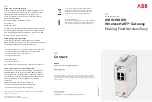
UM380 03 010
55
Manual Configuration or Upgrade of Software Protocol Options
Overlap Signalling Support
If the Q.931 network/equipment supports overlap signalling, enable it by selecting
IN
for
overlap from Q.931,
OUT
for overlap towards Q.931 or
BOTH
.
For transparent signalling, set overlap signalling to
BOTH
directions.
DPNSS Networks In the UK typically support overlap signalling for all calls. InterChange iQ
2000 can be made to block up incoming digits from DPNSS by setting this option to
N
(one) or
I(n). In isolated cases it may be appropriate to turn on pre-emptive call forwarding in the Q.931
stack. This is very rarely required, but if needed operates as described for DPNSS, below.
If the Call Forwarding Timer is disabled (set
0
) the normal Q.931 T302 timer runs to clear
incomplete calls after 15 seconds without dialling activity.
Default Private Network Number
The default Private Network Number is not required for transparency.
When operating into a DPNSS-based public network, which may address to the subscriber number
only, with no private network extension number, it is mandatory that a private network extension
number be supplied, so that non-DDI calls can be directed to a sensible destination such as the
common operator. Normally this would be done in the Q.931 PBX, but in InterChange iQ 2000’s
AT&T and QSIG implementations it can be configured to be supplied by the Converter.
By default non-DDI calls are given a Q.931/QSIG Called Party Address of
0
as the ubiquitous
operator number. This forwarding address can be customised by configuring the appropriate
private network number, including any node address, as the Default Destination Address.
Interface ID
Set the Interface ID Enable configuration parameter to
N
on all InterChange iQ 2000 units.
6.3.2 Port 2 (DPNSS port) Configuration
Level 2 Configuration (LINK)
The default setting of Level 2 for the DPNSS port is A end. This must be configured with
inverse orientation to the attached equipment/network.
Level 3 Configuration (DPNSS)
Default Private Network Number
The default Private Network Number is not required for transparency.
When operating into a Q.931-based public network, which may address calls to the
subscriber number only, with no private network extension number, it is mandatory that a
private network extension number be supplied, so that non-DDI calls can be directed to
a sensible destination such as the common operator. Normally this would be done in the
DPNSS PBX, but it can be configured to be supplied by the Converter.
















































